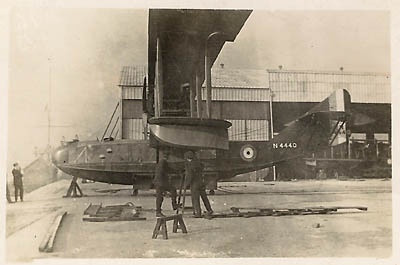Felixstowe Flying-Boats
Photographs
27. Felixstowe F2A Patrol Tractor Biplane N4235
25. Felixstowe F2A Patrol Tractor Biplane N4440
26. Felixstowe F3 Patrol Tractor Biplane N4410
21. Flying-boat towed on a lighter by a destroyer.
Felixstowes are named after the RNAS station at Felixstowe, where new types of flying-boat were developed during WW1. Squadron Leader John Porte became head of the station in 1915 and induced the Admiralty to acquire American flying-boats designed by Glenn Curtiss. These had originally been constructed for a transatlantic service but were adapted for operational use at Felixstowe, thus combining the best of British and American design. The modified aircraft had a new hull designed by Porte with the wings and tail of the original Curtiss and was designated the Felixstowe F1.

Felixstowe F2A N4440 at Dundee, 1918/19
The range and load capacity of the F1 was found inadequate for North Sea patrols and Curtiss was asked to develop a larger aircraft known as the Curtiss H8 or Large America. The hull was again found to be unsuitable for North Sea conditions and was redesigned by Porte, the engines being replaced with more powerful 250hp Rolls-Royce Eagles. This became the F2 and, after a few more modifications, the F2A which was a popular and successful aircraft and remained in use until the end of the war, about 100 being built.
In February 1917 the prototype of a new flying-boat developed from the F2A appeared, designated the F3. It was intended to carry a much heavier load, but the only significant modifications were slightly extended wings and fuselage. The same engines were retained, and consequently the F3 was slower and less manoeuvrable than its predecessor, rendering it less able to engage enemy aircraft and less popular with crews. More F3s were ordered than F2As because of the F3ís 100% greater bomb load, but only about 100 were built, some of these being converted to F5s before completion. Some F3s were used by the RAF in the Mediterranean.
The prototype Felixstowe F5 first appeared in early 1918, with improvements to the hull and wings derived from experience with the former marques. Performance was an improvement upon the F3 but in the interests of economy it was decided to produce only the new hull and otherwise retain as many F3 components as possible. Eventual performance of production aircraft was consequently worse than the F3. The F5 was too late to see operational service but became the RAFís standard post-war flying-boat until replaced by the Supermarine Southampton in 1925. F5s were also produced for the US Naval Flying Corps by Curtiss in the US, an unusual situation in that they were building foreign aircraft originally designed by themselves. The F5 was also the US Navyís standard flying boat until the late 20s.
Identifying the Marques
Identifying the marques can be difficult because they are very similar in appearance and were constantly altered and upgraded. The F5, for instance, was meant to be a complete re-design but for economy reasons was produced using F3 parts as far as possible.
Having read that extension of wingspan was one of the differences between marques of the Felixstowe, I decided to check whether this parameter could be used to separate them. Although wingspans of each marque can be obtained from various sources, it is not possible to obtain reliable direct measurements from photos. It struck me that if only the top wing had been extended the ratio bottom/top wingspan may be measurable from many photos.
| Type & Wing | Length (m) | Ratio 20.86m/upper length |
| F2A Upper | 29.15 | 0.72 |
| F2A Lower | 20.86 | 0.67 |
| F3 Upper | 31.09 | 0.72 |
| F5 Upper | 31.60 | 0.66 |
Measurements taken from reliably identified photographs showed the predicted ratios were correct for the F2A and F3, but that the F5 had a lower/upper ratio close to 0.72.
The F5 can nevertheless perhaps be subjectively identified by the more streamlined and modern appearance of its hull.